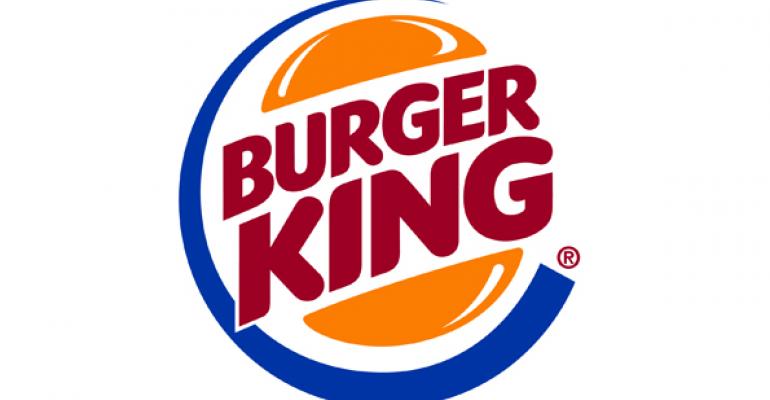This past winter was one of relative contentment for Burger King, at least compared with some of its largest quick-service peers, as its domestic same-store sales rose slightly during the first quarter and franchisee profitability increased “significantly,” officials said.
Rising 0.1 percent in the first quarter, Burger King’s same-store sales at its more than 7,400 North American locations outperformed the 1.7-percent same-store sales decrease at McDonald’s and declines of 3 percent, 5 percent and 1 percent at KFC, Pizza Hut and Taco Bell, respectively, for parent company Yum! Brands Inc.
While leaders of all those chains said the brutally cold winter weather was a major drag on first-quarter performance, Burger King managed a positive result by focusing on value offerings across multiple price points and continuing its marketing strategy for “fewer, more impactful” product launches, said Alex Macedo, president of the brand’s North American division.
RELATED
• Burger King net income soars 68.7% in 1Q
• Report: Burger King to roll out mobile payments
• Burger King at NRN.com
“We’ve had this strategy in place for almost one year now,” Macedo said during the Miami-based company’s earnings call, “and we believe consistency in menu and promotional activity is helping drive our improved performance.”
While even greater same-store sales increases in Burger King’s other markets led to a 2-percent global increase for first-quarter same-store sales, the company’s revenue decreased 26.5 percent to $240.9 million compared with the prior-year period, reflecting the impact of the company’s massive refranchising effort.
The company increased its net income 68.7 percent to $60.4 million, or 17 cents per share, compared with $35.8 million, or 10 cents per share, a year earlier.
Striving for a consistent, balanced menu
In the United States, Burger King’s franchisees increased their restaurant-level profitability “by more than double digits in relation to last year,” despite facing the same weather troubles as competitors and with food costs staying relatively flat, Macedo said. He credited the strategies put in place last year for the uptick in performance, including keeping Burger King’s menu balanced between value offerings and premium limited-time offers while also reducing the number of product introductions.
“What we’ve been doing over the last year by changing our menu innovation platform and focusing on simplifying the restaurant operations is to leverage increased franchisee profitability,” he said. “By reducing complexity, making sure we have strong, impactful launches in our marketing, and really taking close care of how we manage the business in our training … we’ve seen significant increases in franchisee profitability in the United States.”
During the quarter, Burger King introduced the Spicy Original Chicken Sandwich and a bigger version of its Big King sandwich, as well as King Deals, its rebranded value menu of products priced between $1 and $2.
“While these sandwiches helped drive sales and traffic, they also delivered on our priority of simplifying restaurant operations, as their ingredients required no new components in our kitchens,” Macedo said.
Burger King also promoted its 2 for $5 sandwich deal, which would remain one of the ways the chain advertises and introduces new core menu items, Macedo said.
“What’s really going to make the difference for us is having consistency in the long run,” he said. “We think the balanced approach of having value in the restaurant, and introducing products that guests are excited about, is really what’s going to take the United States to the next level in terms of sales in a very consistent way. That for us is important, not only to manage our business but also so that franchisees can increase their profits.”
Planning for the rest of 2014
(Continued from page 1)
Food costs were relatively flat in the first quarter, but Burger King executives expect commodity inflation to increase throughout the year and end up at about 2 percent higher than levels for 2013. However, the company had no plans to take significant pricing action.
“When we talk about pricing with the franchisees, it’s really a relative game we play here in the QSR industry,” he said. “So we expect to take pricing as the market takes pricing, nothing more nothing less. We try to monitor that with extensive consumer research to track how the pricing is moving in the industry every quarter.”
He did add, however, that Burger King would have “a lot of news coming out to the market this year” around digital and mobile ordering. Last month, Burger King said it would have a platform systemwide in the United States to accept mobile payment.
“We think the mobile platform is going to be an integral part of our business in the coming years,” Macedo said. “We see our young consumers totally engaged with their mobile devices, so we’ve been dedicating a lot of significant effort to making sure that we can be at the forefront of QSR when it comes to everything we talk about in the mobile platform, like digital payments, mobile ordering and mobile couponing.”
Burger King is nearly 100-percent franchised and has more than 13,600 restaurants in 97 countries worldwide.
Contact Mark Brandau at [email protected].
Follow him on Twitter: @Mark_from_NRN

